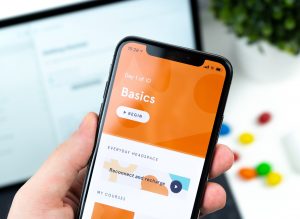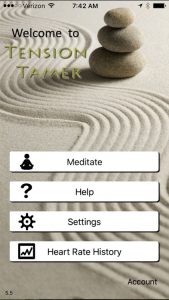Improve Sleep in People with Sleep Disturbance with a Meditation App
By John M. de Castro, Ph.D.
“Sufficient sleep heals our bodies and minds, but for many reasons sleep doesn’t always come easily. Mindfulness practices and habits can help us fall asleep and stay asleep.” – Mindful
Modern society has become more around-the-clock and more complex producing considerable pressure and stress on the individual. The advent of the internet and smart phones has exacerbated the problem. The resultant stress can impair sleep. Indeed, it is estimated that over half of Americans sleep too little due to stress. As a result, people today sleep 20% less than they did 100 years ago. Not having a good night’s sleep has adverse effects upon the individual’s health, well-being, and happiness.
Mindfulness-based practices have been reported to improve sleep amount and quality and help with insomnia. The vast majority of the mindfulness training techniques, however, require a trained therapist. This results in costs that many patients can’t afford. In addition, the participants must be available to attend multiple sessions at particular scheduled times that may or may not be compatible with their busy schedules and at locations that may not be convenient. As an alternative, Apps for smartphones have been developed. These have tremendous advantages in decreasing costs, making training schedules much more flexible, and eliminating the need to go repeatedly to specific locations. But the question arises as to the effectiveness of these Apps in improving sleep in patients with sleep disturbance.
In today’s Research News article “Testing a mindfulness meditation mobile app for the treatment of sleep-related symptoms in adults with sleep disturbance: A randomized controlled trial.” (See summary below or view the full text of the study at: https://www.ncbi.nlm.nih.gov/pmc/articles/PMC7790277/ ) Huberty and colleagues recruited online, adults with moderate sleep disorder, insomnia, and randomly assigned them to a wait-list control condition or to use the “Calm” meditation app for 10 minutes per day for 8 weeks. They were measured before, during, and after for fatigue, daytime sleepiness, pre-sleep arousal, sleep quality, and use of the app.
They found that there was high adherence to app use, with an average of 6.36 uses per week that remained steady over the 8-week intervention period. They found that in comparison to baseline and the wait-list control group, the group that used the “Calm” app had greater reductions in fatigue, daytime sleepiness, and cognitive and somatic pre-sleep arousal. In addition, the group that used the “Calm” app had significant improvements in sleep quality, including falling asleep faster and sleeping longer.
The results of this study suggest that using the “Calm” app improves the sleep of individuals with insomnia and also reduces daytime fatigue and sleepiness, and pre-sleep arousal. The results of this study suggest that using the “Calm” app improves the sleep of individuals with insomnia and also reduces daytime fatigue and sleepiness, and pre-sleep arousal. The results are not surprising as mindfulness training has been shown repeatedly to improve sleep and reduce fatigue. But demonstrating these improvements with an app that is widely available, inexpensive, and convenient to use, is important as the app makes treatment more readily available for a wider group of patients. Hence, the Calm” app would seem to be an excellent treatment for the moderate sleep disorder of insomnia.
So, improve sleep in people with sleep disturbance with a meditation app.
“The idea is to create a reflex to more easily bring forth a sense of relaxation. That way, it’s easier to evoke the relaxation response at night when you can’t sleep. In fact, the relaxation response is so, well, relaxing that your daytime practice should be done sitting up or moving (as in yoga or tai chi) so as to avoid nodding off.” – Julie Corliss
CMCS – Center for Mindfulness and Contemplative Studies
This and other Contemplative Studies posts are also available on Google+ https://plus.google.com/106784388191201299496/posts and on Twitter @MindfulResearch
Study Summary
Huberty, J. L., Green, J., Puzia, M. E., Larkey, L., Laird, B., Vranceanu, A. M., Vlisides-Henry, R., & Irwin, M. R. (2021). Testing a mindfulness meditation mobile app for the treatment of sleep-related symptoms in adults with sleep disturbance: A randomized controlled trial. PloS one, 16(1), e0244717. https://doi.org/10.1371/journal.pone.0244717
Abstract
The objective of this randomized controlled trial was to test whether a commercially available, mindfulness meditation mobile app, (i.e., Calm app), was effective in reducing fatigue (primary outcome), pre-sleep arousal, and daytime sleepiness (secondary outcomes) in adults with sleep disturbance (Insomnia Severity Index Score >10) as compared to a wait-list control group. Associations between the use of the Calm app (i.e., adherence to the intervention) and changes in sleep quality was also explored in the intervention group only. Adults with sleep disturbance were recruited (N = 640). Eligible and consenting participants (N = 263) were randomly assigned to the intervention (n = 124) or a wait-list control (n = 139) group. Intervention participants were asked to meditate using the Calm app ≥10 minutes/day for eight weeks. Fatigue, daytime sleepiness, and pre-sleep arousal were assessed at baseline, mid- (4-weeks) and post-intervention (8-weeks) in both groups, whereas sleep quality was evaluated only in the intervention group. Findings from intent-to-treat analyses suggest the use of the Calm app for eight weeks significantly decreased daytime fatigue (p = .018) as well as daytime sleepiness (p = .003) and cognitive (p = .005) and somatic (p < .001) pre-sleep arousal as compared to the wait-list control group. Within the intervention group, use of the Calm app was associated with improvements in sleep quality (p < .001). This randomized controlled trial demonstrates that the Calm app can be used to treat fatigue, daytime sleepiness, and pre-sleep arousal in adults with sleep disturbance. Given that the Calm app is affordable and widely accessible, these data have implications for community level dissemination of a mobile app to improve sleep-related symptoms associated with sleep disturbance.
https://www.ncbi.nlm.nih.gov/pmc/articles/PMC7790277/









